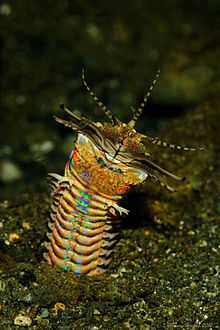Eunice aphroditois
| Eunice aphroditois | |
|---|---|
 | |
| Scientific classification | |
| Kingdom: | Animalia |
| Phylum: | Annelida |
| Class: | Polychaeta |
| Order: | Eunicida |
| Family: | Eunicidae |
| Genus: | Eunice |
| Species: | E. aphroditois |
| Binomial name | |
| Eunice aphroditois Pallas, 1788 | |
Eunice aphroditois, colloquially known as the Bobbit worm, is an aquatic predatory polychaete worm dwelling at the ocean floor. This organism buries its long body into an ocean bed composed of gravel, mud or corals, where it waits patiently for outside stimulus to reach one of its five antennae, attacking when it senses prey. Armed with sharp teeth, it is known to attack with such speeds that its prey is sometimes sliced in half. Although the worm hunts for food, it is omnivorous.[1]
According to Luis F. Carrera-Parra and Sergio I. Salazar-Vallejo, ecologists specializing in annelid polychaetes at El Colegio de la Frontera Sur (ECOSUR) in Campeche, Mexico, the eunicid injects "...[a] narcotizing or killing toxin in their prey animal, such that it can be safely ingested — especially if they are larger than the worm — and then digested through the gut".[2] They further state that, unlike a different family of worms, the fireworms (Amphinomidae), which have harpoon-shaped chaetae (bristles) that release a toxin that can cause severe skin irritation, E. aphroditois "do not have abundant chaetae and their chaetae are not used for defensive purposes, but for improving traction for crawling over the sediment or inside their galleries or tubes".[2]
Little is known about the sexual habits and lifespan of this worm, but researchers hypothesize that sexual reproduction occurs at an early stage, maybe even when the worm is about 100 millimetres (3.9 in) in length; this is very early, considering that these worms can grow to sizes of nearly 3 metres (9.8 ft) in some cases (although most observations point to a much lower average length of 1 metre (3 ft 3 in) and an average of 25 millimetres (0.98 in) in diameter). A long lifespan may very well explain the size of these creatures.
Eunice aphroditois is found in warmer oceans around the world, including the Indo-Pacific and Atlantic.[3]
In aquaria
In March 2009, the Blue Reef Aquarium in Newquay, Cornwall, England, discovered a Bobbit worm in one of their tanks. The workers had seen the devastation caused by the worm, such as fish being injured or disappearing and coral being sliced in half, but didn't find it until they started taking the display apart in the tank.[4] Bobbit worms may be accidentally introduced into artificial environments.[5] Another Bobbit worm, three and a half feet long and a couple of inches thick, was found October 7, 2013 in Maidenhead Aquatics in Woking, Surrey, England.[6]
References
- ↑ Becky Crew. "Eunice aphroditois is rainbow, terrifying". Scientific American. Retrieved 2013-03-13.
- ↑ 2.0 2.1 Simon, Matt. "Absurd Creature of the Week: 10-Foot Bobbit Worm Is the Ocean's Most Disturbing Predator - Wired Science". Wired.com. Retrieved 2013-09-09.
- ↑ SeaLifeBase (19 July 2012). Eunice aphroditois. Retrieved 3 June 2013.
- ↑ "Barry the giant sea worm discovered by aquarium staff after mysterious attacks on coral reef". Daily Mail (London). 2009-03-31.
- ↑ Schulze, Anja (December 2011). "The Bobbit Worm Dilemma: A Case for DNA". Revista de Biología Tropical 59 (4): 1463–1474. Retrieved 7 September 2013.
- ↑ "Secret giant worm behind mystery of vanishing aquarium fish". The Telegraph. 18 October 2013. Retrieved 24 October 2013.
External links
- Keith Davey (2000). "Eunice aphroditois". Life on Australian Seashores. Retrieved 2007-10-10.
- Bannister, JV; Bannister, WH; Anastasi, A (1976). "Isolation, characterization and oxygen equilibrium of an extracellular haemoglobin from Eunice aphroditois (Passas)". The Biochemical journal 159 (1): 35–42. PMC 1164035. PMID 11776.
- Fauchald, Kristian (1992). "Eunice aphroditois (Pallas, 1788)". A Review of the Genus Eunice (Polychaeta: Eunicidae) Based upon Type Material. Smithsonian Contributions to Zoology. Smithsonian Institution Press. pp. 62–4. doi:10.5479/si.00810282.523. hdl:10088/6302.
- Image of the worm.
- More images of the worm.
- Scott Gietler. "The Bobbit worm, Eunice aphroditois". Underwater Photography Guide. Retrieved 2013-10-14.